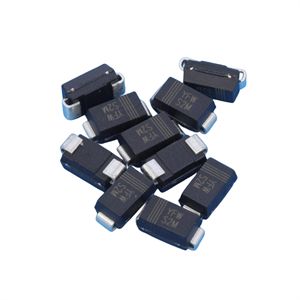Date:2024-10-06 Categories:Product knowledge Hits:281 From:Guangdong Youfeng Microelectronics Co., Ltd
Diodes are basic electronic components and are also very common in electronic circuit applications. How to avoid overload damage to diodes during application?
Dissipation power, also known as maximum allowable collector dissipation power PCM, refers to the maximum collector dissipation power when the transistor parameters do not exceed the specified allowable value. It refers to the total active input power and active output of power grid components or the entire network at a certain moment
The difference in total power output. Under linear conditions, the calculation of dissipated power during conduction is relatively simple, with PD=I2R or PD=U2/R; In the on/off state, the calculation is relatively complex.
The dissipated power of a diode is related to the allowable temperature, with a maximum allowable temperature of 150 ℃ for silicon diodes and 85 ℃ for germanium diodes. The operating temperature of semiconductors is limited, and as the actual power increases, its temperature will also increase,
When the temperature reaches 150 ℃, the power at this point is the maximum dissipated power. Of course, the dissipated power is also related to the size of the package. Generally, devices with larger packages have relatively higher maximum dissipated power, and the most common is high-power
The rate device has a large volume and a large area of heat dissipation metal surface.
The dissipated power of a specific type of diode is related to the testing conditions, such as the testing environment temperature and heat dissipation conditions. Normally, the maximum dissipated power tested is at 25 ℃. As the ambient temperature increases, its maximum
The dissipated power will decrease because the thermal conductivity temperature difference under this condition becomes smaller. For example, at 25 ℃, the dissipated power of a certain diode can reach 1W, and at 75 ℃, the dissipated power may become 0.4W. Allow maximum dissipated power and heat dissipation conditions
Regarding, the better the heat dissipation conditions, the higher the dissipated power. At the same ambient temperature, the dissipated power is 1W. After adding heat sinks, the dissipated power may become 1.7W.
One parameter that characterizes heat dissipation measures is thermal resistance. Thermal resistance is a comprehensive parameter that reflects the ability to prevent heat transfer. Thermal resistance, similar to resistance in electronics, is a reference quantity that reflects the size of the "blocking ability". The smaller the thermal resistance, the stronger the heat transfer ability;
On the contrary, the larger the thermal resistance, the smaller the heat transfer capacity. From an analogy perspective, heat is equivalent to current, temperature difference is equivalent to voltage, and thermal resistance is equivalent to resistance. Among them, thermal resistance Rja: the total thermal resistance of the chip's heat source junction to the surrounding cooling air, measured in ℃/W, representing the temperature difference between the two ends of the heat conduction at 1W.
At 0-50 ℃, the dissipated power remains constant at 400mW. At 50-150 ℃, the dissipated power decreases linearly until reaching 150 ℃, where the dissipated power is 0. At this temperature, the silicon transistor can no longer function. From this table, the thermal resistance can be calculated
Inverse slope of linear part:
|1/k|=Rja=(150-50)/0.4=250℃/W
According to this table, we can obtain:
PD=-1/250(TA-50)+0.4,(TA-≥50)
According to the above formula, we can calculate the maximum dissipated power of the 1N4148WS switch diode at different ambient temperatures.
In the actual circuit design process, most R&D engineers pay more attention to the temperature during device operation to ensure a safe working range. Taking 1N4448WS as an example, at an ambient temperature of 50 ℃ and an actual power of 200mW, its temperature is 50+250 * 0.2=100 ℃, and it can work normally; When the actual power is 400mW, the temperature is 50+250 * 0.4=150 ℃. At this point, the maximum temperature for throttling has already been reached, which is quite dangerous and should be avoided.
In terms of heat transfer in diodes, the main considerations are PD and thermal resistance Rja. The former is the maximum dissipated power, which cannot be exceeded in actual operation, while the latter is a heat transfer resistance parameter that reflects the heat transfer capacity of different diodes. When using diodes, not only should forward current, reverse withstand voltage, and switching time be considered, but also dissipated power should be taken into account.

Previous: Classification, Structure, and Principle of MOSFET
Next: Using voltage inspection method to quickly locate fault points in integrated circuits